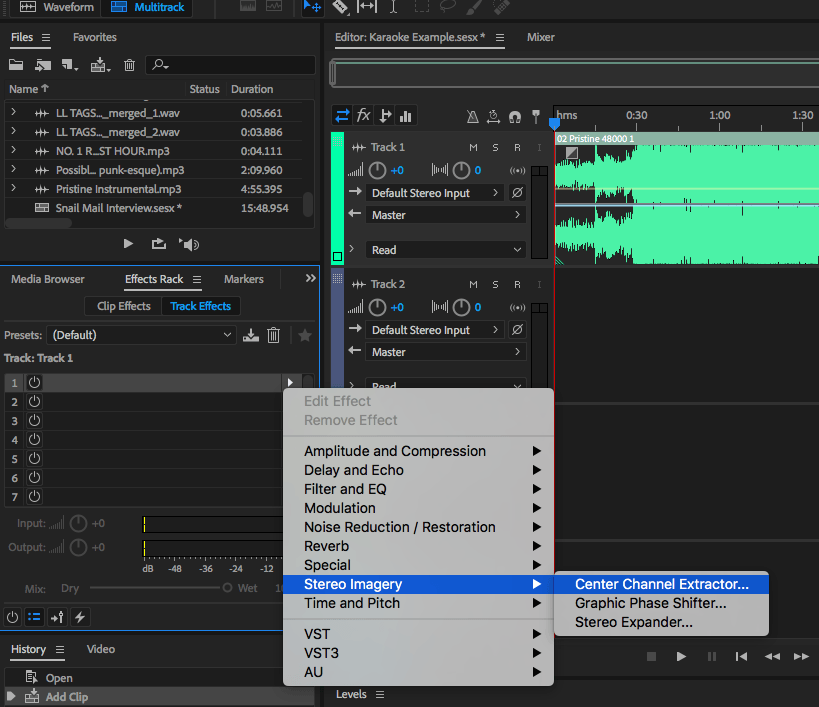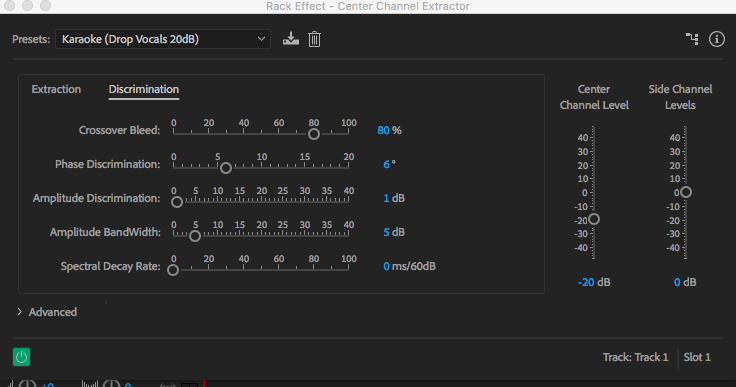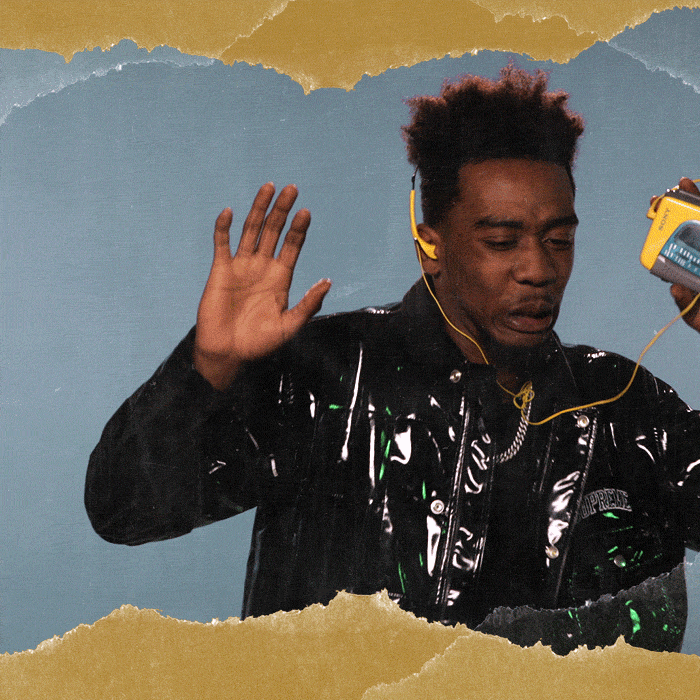Make sure to like and subscribe to my YouTube channel here!
Category: Uncategorized
Women on (Air)waves Trailer
Like what you see? Make sure to like and subscribe to my new channel here!
How-to: Create Your Own Karaoke Track with Adobe Audition
I’ll be the first to admit it: I take karaoke a little too seriously. Like, way too seriously. If it means losing my voice just to impress the room with my rendition of a Whitney Houston ballad, I will do it in a heartbeat. But what happens when you’ve found the perfect karaoke song, one that’s right in your range and bound to get the party started, but you can’t find a karaoke version of it anywhere? Well, honey, you’ll just have to create your own! Using Adobe Audition, the process of making your own karaoke instrumental to belt along with is super simple.
You Will Need:
-Adobe Audtion CC 2018
-An .mp3 or .wav of your chosen song
-Ears
Step 1: Create a new Audition Multitrack Session
If you’ve dabbled in Audition before, this should be self-explanatory. If not, aquaint yourself with the Multitrack function here.
Step 2: Import your chosen song and place it into your track of choice
Aren’t familiar with importing media into Audition, either? Try this turotial on for size.
Step 3: In the “Effects” rack, select “Stereo Imagery”>”Center Channel Extractor”

The Center Channel Extractor will be your best friend when it comes to creating the karaoke tracks of your dreams (and can also do a lot of other neat things that we won’t cover in this how-to).
Step 4: When the Rack Effect adjuster appears, use the drop down menu next to “Presets” to select “Karaoke (Drop Vocals 20 dB)”

Adobe is filled with all kinds of useful presets, and this one will serve as our foundation to bring down the volume of the vocals in the song.
Step 5: Give the track a listen with this effect added

Notice how the Center Channel Levels and Side Channel Levels shifted to -20 dB and 0 db, respectively, once adding the Karaoke preset. You should notice an immediate difference in the volume level of the song’s vocals, but depending on how the track was mixed there may still be some residual vocals to take care of. Don’t fear, there are still a few more adjustments you can make to take care of those.
Step 6: Adjust your Discrimination Settings (particularly Crossover Bleed and Phase Discrimination)

Click on the “Discrimination” tab next to “Extraction” to bring up even more options to fine-tune your karaoke track. Crossover Bleed and Phase Discrimination will be especially helpful in achieving the sound you are looking for. Play your track in Audition while you play with these settings, as each song will require different levels to get the right sound.
Step 7: Export your new karaoke track and sing your heart out!
Once you have your track mixed to your liking, export your file and get ready to blow your friends away with both you tech and vocal abilities.
As an example, I took the song “Pristine” by WoW’s favorite indie darling Snail Mail and mixed it into a mostly instrumental, karaoke ready track. You can listen to the final results below:
I hope this how-to was helpful! What songs are you dying to make into your next karaoke smash-hit? Let me know down below!
5 Podcasts You Should Be Listening to (If You Aren’t Already)
If you’re an audio nerd, there’s a good chance that you’re also a podcast nerd. It’s rare to find someone with a bare grasp of the basic of recording that hasn’t tried to make their own podcast with their friends at some point (myself included). But not all podcasts are created equal, and there are plenty out there to sift through on the internet before you finally strike pod-gold. In an effort to make your life a little easier, and your listening experience more enjoyable, here are my top 5 podcasts that you’ve gotta give a listen (if you aren’t already a mega-fan).
5. How Did This Get Made?
If you’re a lover of movies so-bad-they’re-good, this is the podcast for you. Join hosts Paul Scheer, Jason Mantzoukas, and June Diane Raphael as they get down and dirty with some of the worst films ever made. From Kazaam to The Twilight Saga, this gang has covered it all, and hilarity, without fail, ensues. If you’re looking for a podcast to turn your frown upside down, How Did This Get Made? does the job.
4. Gilmore Guys
Who knew that the missing piece in my life was a podcast where two dudes talk about the TV classic Gilmore Girls? I sure didn’t until I got my hands on this one. Kevin T. Porter and Demi Adejuyigbe (and various guest hosts) go deep into the world of Stars Hollow, breaking down each episode with a combination of wit and sincerity. If you’ve ever felt a kinship with the Gilmore Girls, it’s time to welcome the Gilmore Guys into your playlist.
3. Getting Curious with Jonathan Van Ness
Before Jonathan Van Ness became everyone’s favorite member of the cast of Queer Eye, he was busy getting curious on his very own podcast. Jonathan brings his signature charm and humor to investigating a wide range of topics, from renaissance art to pirates to the Armenian genocide, bringing experts on each topic to the show to enlighten us. If you’re looking to laugh and learn something new, then it’s time to Get Curious.
2. Sawbones: A Marital Tour of Misguided Medicine
What happens when a doctor and her professional podcaster of a husband get together to talk medicine? Laughter (and learning) ensues. Dr. Sydnee McElroy and Justin McElroy team up to tackle the history of medicine, from an expert (and not so expert) point of view. If you’ve got a funny bone in your body, Sawbones is just what the doctor ordered.
1. The Relentless Picnic
It’s difficult to put a label on The Relentless Picnic, which is maybe why I like it so much. Is it a comedy podcast? Is it social commentary? Is it academic? It’s a little bit of everything: Intellectually stimulating, thought provoking, and, often, hilarious. Whatever George Lazenby, Adam Juskewitch, and Erikk Geannikis find themselves dissecting, I’m always happy to come along for the picnic.
Did I leave any of your favorites off my list? What are the must have podcasts in your life? Let me know in the comments!
Interviews on (Air)Waves: Snail Mail
While a band name like Snail Mail implies a degree of slowness, nothing about Lindsey Jordan’s blossoming career has moved at a snail’s pace. The 19 year old frontwoman of the Baltimore-based rock group Snail Mail is only fresh out of high school, but has already released one buzz-worthy EP and dropped the band’s debut album, Lush, just earlier this month. The album has already received critical acclaim from the likes of Rolling Stone Magazine and Pitchfork, with tastemakers quick to name the band as one of the most promising new prospects in independent rock.
I chatted with Lindsey in the days following Lush’s release to chart her feelings surrounding the album’s reception, the insatiable urge to keep creating, the future of the band, and more.
On playing the venues she grew up attending
“It’s amazing; that show was totally surreal. I almost forgot how big (historic bar and music venue in Washington D.C.) Black Cat was until I looked out into the crowd and it was totally packed. I’ve been going there since I was like 13, so it was really amazing. Everyone has been really supportive and nice, and the crowd was amazing.”
On her new album Lush‘s critical acclaim
“I kind of put the validation in the same boat as the mean stuff, in that I try to let it roll off so it doesn’t really effect my song writing or how I go about playing shows or anything in my life. Everything is a factor that brings me further away from where I started, which makes the songwriting process inorganic. I sorta try to keep it all in its own category and keep it away from how I do things. It is very sweet, and I love playing to sold our crowds; that’s been amazing. I’m really glad that people are connecting with it and its really great hearing people every night saying they can bring their own context to the record. Everyone seems to have a deep personal connection with it which is probably the most that I can ask for as a songwriter.”
On the differences between recording the Habit EP and Lush
“It was like night and day. I was able to choose the producer very carefully and choose where we were recording. We made demo versions of the record and a rough draft version of the record, and then spent awhile in upstate New York making the main full band tracks. We took huge amounts of time in the middle to sit with what we’ve done in each session. So we took a year and a half to wroite the songs and six months to make the record. Everything was super deliberate, and I had my hands all over everything and was there for every step of the mixing. I learned a ton about the recording process. We had so many more resources and it was just this huge prouction, while with “Habit” we were rcording in our friends basement studio and there wasn’t a lot of room to add in different instruments or lay down much more than I had already come into the studio with written. We made a lot of alterations in arrangements and there was a lot more space to add in third or fourth guitar tracks, so I was able to expand on what I came into the studio with. It was this big, huge productions and process, and it was incredible. Totally different than anything I’ve ever done.”
On where she sees Snail Mail headed next
I think that consideration has been in the back of my mind since I finished “Lush”, which was kinda forever ago. I’m having a really hard time not taking it a day at a time. I think the key to staying sane is just making sure evrything gets done everyday and allowing yourself to breathe and being forgiving with yourself. I feel like I have a lot of ideas and I’ve been writing only when I get that rush of inspiration, and not forcing myself since I’ve been so busy and stressed. It’s a lot to have to get everything done that I have to do today. I’m kinda waiting until everything dies down a little more to start really considering what’s next. I try to write a little bit every day, whether it poetry or journal entires or just little riffs or songs, just to make the songwriting process less daunting. I feel like lyrically I’ve really shifted with writing these new songs on LP 2. I feel like after talking so much about these experiences and other people I really want to focus more on myself. I’m sorta in the self-preservation zone and I’ve seen so much more and been to so many places and feel a lot more inspired by my constantly changing surroundings, than specific instances and how people have shaped my life, which I feel like is a lot of what Lush is. I feel a lot more focused on my own personal development and my new life in transit.”
On what she would be doing if she weren’t making music
“I have some dream of writing a book one day. That was kinda the direction I was headed in when I was planning on going to college. I’m a writer before I’m anything else. I also really love all the fashion stuff I’ve been able to do with this, so anything fashion related I’m down. I’d love to go further with that and do more with that world.”
Lush is out now on Matador Records.
What are your thoughts on Snail Mail’s new LP, if you’ve given it a spin? Which indie darling should I talk to next? Let me know in the comments!
How DJs celebrate the Fourth of July
1. Be shocked you got the day off in the first place.
It may seem too good to be true, but you actually have a holiday off. Get ready to celebrate (and leave your poor co-workers who weren’t as fortunate in the dust)!
2. Create the ultimate cook-out party playlist.
Just because you have the day off from your DJ duties doesn’t mean you’re going to let some amateur grab the aux cord at the Fourth barbeque. Time to create a playlist that will be the envy of all of your friends and family. You know when to keep the mood chill, how to amp up the fun during that early evening post-sunburn lull, and have already timed out the tunes to sync up perfectly with the evening fireworks display. Too bad you aren’t getting paid for this.
3. Try your best to enjoy the festivities (but keep getting distracted by work things)
You’ve got your feet dipped in the pool, a cool beverage in your hand, and not a care in the world…until yet another work email filters in on your phone.
Pitches, promos, and deadlines are impossible to escape from. You even find yourself bookmarking news and stories that you know will be great fodder for your mic breaks tomorrow. Cut it out! Put the phone down and commence relaxation.
4. Actually have fun

You’ve hidden your phone inside under a couch cushion, and now it’s time to truly enjoy yourself. Do some sick tricks off of the diving board, eat too many hot dogs, and roast the other team in a game of beach volleyball. By the time the fireworks come around, you’ve totally forgotten all of your work worries.
5. Go home and prepare for an early morning
Well, you’ve had your Fourth of July fun, but the grind never stops for long. Head home and prepare for a wake-up call that will come much too early. You may show up to work tomorrow sleep-deprived and sunburnt, but boy was it worth it.
Hope you all had a great Fourth of July? How did you spend the holiday? Let me know in the comments!
Interviews on (Air)waves: Lucy Dacus
As some of you may know, on top of my work as a blogger I am also working as a production intern on the Border Crossings music show at Voice of America. It may not be paid, but the gig does have a surprising number of quirks. Recently, this manifested in the chance to talk with Lucy Dacus, one of my current favorite singer-songwriters, at the Firefly Music Festival in Dover, DE.
Lucy and I chatted about who she’s rooting for in the World Cup, the surrealism involved with going from small gigs to festivals, and the rewards of sharing her brand of vulnerable music with world.
This piece was first broadcast on VOA 1’s Border Crossings program.
Keep Lucy on your radar, and give her newest album Historian a listen.
Who should I interview next? Do you have any bands I should add to my playlist? Leave a comment below and let me know what you think!
Ditch Those Earbuds: Top Headphones for Audio Recording & Editing
Ah, the Apple Earbud. They’re portable, cute, and come with every iPhone Apple sells. They’re the easy option for listening to your favorite tunes on the go, but there is one thing that they should NEVER be used for: AUDIO MIXING
For creating quality audio production, you will need to invest in a good pair of studio headphones. These headphones differ from your average Beats by Dre, giving you an accurate idea of what you are listening to (AKA no built-in bass boosters or other doodads to interfere with the naturally occuring frequencies of the track). While studio headphones won’t replace your need for a solid set of reference monitors for mixing, they can come in handy when you need to deal with small details in a track or mix in a otherwise noisy room (Kornienkov, 2014).
Now that you’re ready to abandon those easily-tangled earbuds and upgrade to some more serious hardware, your next question is probably this: What studio headphones should I get?
This decision is going to be determined by two factors:
-Which are you primarily doing: recording, or mixing?
-What is your budget?
If you’re recording more often, buy Closed Back Headphones
Closed back headphones are a recording engineer’s delight. These headphones keep sounds from leaking out during a recording session and potentially ruining an otherwise killer take. A pair of these babies will give you the ultimate sound isolation you need laying down great sounding audio tracks.
Buying on a budget? Try…
Sony MDR-7506
Price: $79.99 (Amazon)
The Reviews Are In: “The Sony MDR7506 are quite famous (we still have our pair after 10 years or so) and have stood the test of time. They’re rated highly for the overall solid build, have great mid-range performance and great sounding bass..we still have our MDR’s lying around here in the office and trust us, they’ve definitely stood the test of time now.”
Able to splurge? Try…
Shure SRH-1540
Price: $499 (Amazon)
The Reviews Are In: “The Shure SRH-1540 is perhaps the closest you could ever come to reference quality sound in a pair of closed back headphones…Somehow, you can tell just by looking at them how ridiculously comfortable they are..if someone specifically asked me for the BEST of the BEST, I would no-doubt point them in the direction of the Shure SRH-1540.”
If you’re mixing more often, buy Open Back Headphones
Sadly, what goes up must come down. This includes your studio headphone: the more isolation your headphones allow you, the worse the sound quality will be. Open back headphones have…well, a more open back, leading to less isolation. Therefore, they are perfect for the mixing process of your project.
Buying on a budget? Try…
AKG K240
Price: $59 (Amazon)
The Reviews Are In: “For beginners on a tight budget, there’s no safer bet than the AKG K240…If you only have enough cash for one purchase, and you need a set of headphones suitable for BOTH recording and mixing…It’s one of the few options in this price range that delivers on its promises.”
Able to splurge? Try…
Sennheiser HD 650
Price: $366.99 (Amazon)
The Reviews Are In: “If there is one pair of headphones in the World synonymous with high-end sound…It’s the Sennheiser HD 650. A long time favorite in both audiophile, and pro audio circles…Chances are, they’re the most comfortable headphones you will ever wear.”
Did I leave your ride or die pair of headphones off of my list? Let me know in the comments which pair of studio headphones are your personal favorite!
Sources:
E-Home Recording Studio. “The Ultimate Guide to Studio Headphones for Home Recording”. Retrieved from here
Kornienkov, A. 2014, Feb 4. “What is the difference between studio and regular headphones?” Retrieved from here
Production Music and SFX Trouble? No Worries!
It is a fact that can’t be understated: prouction music and sound effects can make or break an audio project. Finding just the right door squeak or amped up rock instrumental can elevate your video from one of a dozen to one in a million. However, finding production music and SFX that you are legally allowed to use can always be tricky. After all, no audio masterpiece is worth getting sued over.
To keep you sounding right on and out of legal trouble, here are three suggestions for compiling just the sounds you need.
1. Free SFX Websites
Buying a library of professionally made SFX can be pricey. If you’re an amateur creater, it’s almost certainly out of your budget. However, there are plenty of websites out there to help you achieve aural greatness on a dime. Freesound is my personal go-to for all of my SFX needs, and describes itself as “a collaborative database of Creative Commons Licensed sounds” (AKA, sounds that you are legally allowed to use in your productions for free). For many of these sounds you will still need to provide credit to the user who created it, but a shout-out in the credits of your creation is a small price to pay in exchange for this great collection.
2. Public Domain
A tried and true source for all kinds of goodies, the public domain is a great resource for recycling the old to help make something new. The public domain includes everything that has fallen out of copyright and is now considered a good of the people. The domain includes classic music, movies, books, and more, and can be a perfect place to source production music from. However, make sure you educate yourself on the intricacies of the system first. Always ensure that you are able to verify that a selection is in the public domain before using it; you can’t just assume that because a song is old that it is out of copyright.
3. Make Your Own!
While it may seem easier to find a prerecorded piece for your audio projects, don’t underestimate the value of getting creative! Don’t have access to the crunching sound you’re looking for? Use some household objects and create your own! The price to license the perfect tune for your project is more than you make in a year? Get your musician friends together and write your own stellar instrumental. Never underestimate the tools you have at your own disposal to make something that sounds great.
While these are just a few of my favorite suggestions, there are infinite ways to go about making your audio project the best it can be. Leave a comment below with your best recommendations for finding SFX and production music!
Why I Love Adobe Audition
It seems that every audiophile has their own favorite audio production software. Industry bigwigs are enamored with Pro Tools, Cubase has a longstanding reputation with its fans (such as the honorable Dr. Piwinsky), and for those just starting out, a free copy of Audacity often gets the job done just fine. While all of these software options do roughly the same tasks, each has their own ways of accomplishing the ultimate goal of creating some bangin’ audio. Well, after trying many of the options out there, I have found that not all software is created equal, and I’m happy to say that I have discovered my own personal favorite audio software: Adobe Audition. Allow me the chance to wax poetic about why this program has become my go-to for all of my production needs.
1. It’s affordable.
Good audio production software can be expensive. Pro Tools, the industry standard, starts at $599 (!), and the more deluxe versions can cost thousands of dollars (Thornton, 2018). For those just starting out, this software is typically financially out of reach (and, ultimately, overkill for many). But what if I told you that you could get not only Adobe Audition, but the entire Adobe Creative Cloud (featuring Pemiere, Photoshop, and more), for only $19.99 per month?
I know it sounds crazy, but if you’re a college student currently enrolled in an accredited university, you can have access to the full range of Adobe Creative software for the monthly cost of a overpriced t-shirt. If audio editing is only part of the creative work you do, this is a deal that can’t be beat, and even if you’ve never edited photos or videos in your life, this is a great opportunity to broaden your portfolio and gain additional experience in other mediums without breaking the bank.
2. It’s easy to use.
There are some audio programs out there that seem like they want you to fail at using them. Menus are set up illogically, features seem impossible to apply correctly, and you find yourself watching tutorial after tutorial just to do something as simple as record on a track. While many things in life are worth working for, accomplishing simple tasks in a software you spent way too much money on shouldn’t be one of them.
With Audition, I never find myself second guessing the programmers’ logic or wondering “Why the heck would they put that there?” The software is simple, direct, and doesn’t leave you guessing. When I first began working with Audition, I didn’t find myself overwhelmed and frazzled like I often did learning other programs (I’m looking at you, Cubase). Adjusting volume and panning, adding effects, and recording and playing with audio files are all done simply, and it all begins to feel very intuitive after you get acquainted with the tools. If you ever find yourself in a situation where you aren’t quite sure what to do next, Adobe is kind enough to include tutorials on a number of things you can accomplish within the program. If you are actively seeking to be challenged by a program, Audition probably isn’t for you, but if you’re looking for audio production software that makes editing enjoyable and easy breezy, you’ve found your match in Audition.
3. It does so much!
Often, affordability and ease of use for a program means that functionality and capability tend to be more limited. I can say that that is truly not the case when it comes to Audition. In fact, I still find myself surprised by everything that I can do within the program. File conversion? Audition does it. Flawless noise correction? Audition does that, too. Multitrack recording? Audition even does that (and it’s one of the few programs that does!). It’s hard to think of a project that you couldn’t tackle with ease with this software on your side. While you may not have ALL of the tools available on a software that’s costs 10x Audition’s price, there is nothing that an amateur (and even most professionals) won’t be able to accomplish with what is offered by Audition.
While every product has its pros and cons, I can say that Adobe Audition is the best time that I’ve had editing audio. Knowing that I’m not breaking the bank, being able to navigate the software with ease, and the nearly limitless potential that its tools give me provides me with the peace of mind I need to really dig into a project and milk it for all that it is worth.
Do you share my love for Audition, or do you have another favorite to vouche for? Let me know in the comments!
Sources:
M. Thornton. (2018, Feb 19.) Pro Tools FAQs – How Much Does It Cost To Buy Pro Tools? Retrieved from




